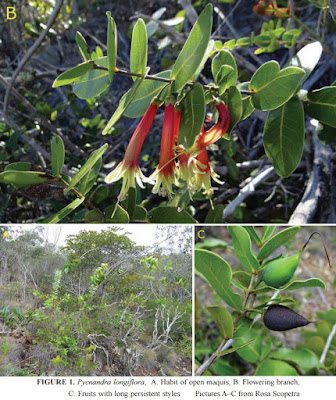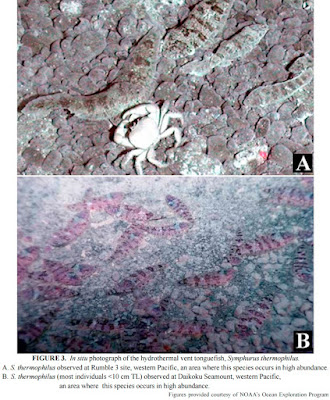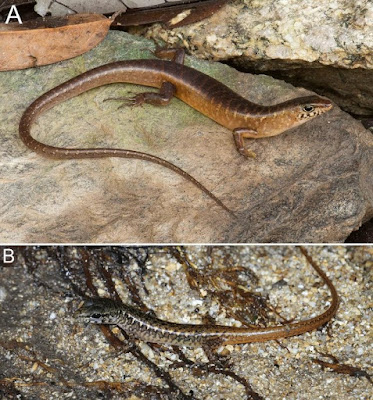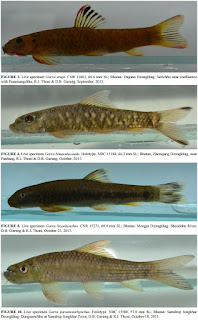[Most Recent Entries] [Calendar View]
Saturday, October 29th, 2016
| Time | Event | ||||
| 3:28p | [Botany • 2016] Pycnandra longiflora • A Species (Sapotaceae) Believed to be Extinct, rediscovered in New Caledonia
Abstract Pycnandra longiflora (Sapotaceae) belongs to the largest endemic genus in New Caledonia. It is only known from the type collection made in 1861–67 at the obscure locality “Gatope”. Relocation of this species has been of high priority for more than a decade, but without success. Pycnandra longiflora was therefore recently declared extinct. However, a population was recently discovered near a mining site at Onajiele, in the Ouazangou-Taom massif, and it is revealed that P. longiflora has the most spectacular flowers in the entire genus, being large and bicoloured in red and yellow. A thorough description is here outlined and we propose a preliminary IUCN status as Critically Endangered. Keywords: Extinct species, rediscovering, extended description, prospection, Eudicots Pycnandra longiflora (Benth.) Munzinger & Swenson, Austral. Syst. Bot. 28: 101 (2015) Conclusion: Pycnandra longiflora is not extinct and grows less than 600 metres from the main road (RT1) of “Grande-Terre”, close to an accessible track (Figure 2). This is a very important locality of native vegetation as a new species of Myrtaceae, Eugenia plurinervia Snow, Munzinger & Callm. (2016: 212), also occurs here. Several other rare species such as Planchonella minutiflora Munzinger & Swenson (2009: 182), Croton cordatulus Airy Shaw (1978: 387), Euodia tietaensis (Guillaumin) T.G. Hartley (2001: 56) are also present, which clearly indicates that the place has high conservation value. The rediscovery of this P. longiflora supports continuing botanical surveys in New Caledonia, to provide sound data for conservation assessments. Jérôme Munzinger and Ulf Swenson. 2016. Pycnandra longiflora (Sapotaceae) A Species Believed to be Extinct, rediscovered in New Caledonia. Phytotaxa. 278(2); 176–180. DOI: 10.11646/phytotaxa.278.2.9 What's in the Box? A Long-Lost Species blogs.scientificamerican.com/extinction-c Jérôme Munzinger and Ulf Swenson. 2015. Revision of Pycnandra subgenus Leptostylis and description of subgenus Wagapensia (Sapotaceae), A Genus endemic to New Caledonia. Australian Systematic Botany. 28; 91–110. DOI: 10.1071/SB15010 | ||||
| 7:37p | [Ichthyology • 2008] Symphurus thermophilus • A New Western Pacific Tonguefish (Pleuronectiformes: Cynoglossidae): The First Pleuronectiform discovered at active Hydrothermal Vents
Abstract Symphurus thermophilus n. sp., described from 16 specimens collected by submersibles, ROV, epibenthic sled and dredge, occurs on a variety of substrata at several active hydrothermal sites located at 239–733 m between 21°N and 35°S in the western Pacific Ocean. Symphurus thermophilus, the only pleuronectiform fish known to inhabit hydrothermal vent areas, is characterized by the combination of a 1–2–2–2–2 pattern of interdigitation of dorsal proximal pterygiophores and neural spines, 14 caudal-fin rays, 5 hypurals, 9 abdominal vertebrae, 47–51 total vertebrae, 88–94 dorsal-fin rays, 74–80 anal-fin rays, 100–112 scales in longitudinal series, ocular-side pigmentation pattern featuring 5–8, black, mostly incomplete crossbands, uniformly white blind side, and black peritoneum. Of specimens examined, seven including the holotype, were collected on Kaikata Seamount off southern Japan; one specimen was collected at the Kasuga-2 hydrothermal vent, Marianas Islands; and six were collected at sites on the Kermadec Ridge. In addition to specimens captured, many other S. thermophilus were observed from submersibles and ROVs at hydrothermal sites in the western Pacific including those in the Marianas Islands, at Nikko Seamount near Minami-Iohjima Island, and at Minami-Ensei Knoll, Mid-Okinawa Trough. Many of the specimens examined have skeletal anomalies including fused bones in the caudal skeleton, and missing or partially developed and/or misshapen fin rays. Key words: flatfish, Symphurus, hydrothermal vents
Thomas A. Munroe and Jun Hashimoto. 2008. A New Western Pacific Tonguefish (Pleuronectiformes: Cynoglossidae): The First Pleuronectiform discovered at active Hydrothermal Vents. Zootaxa. 1839; 43–59. | ||||
| 8:14p | [Herpetology • 2016] Sphenomorphus sungaicolus • The First Riparian Skink (Genus: Sphenomorphus Strauch, 1887) from Peninsular Malaysia and Its Relationship to other Indochinese and Sundaic Species
Abstract Recently discovered populations of skinks of the genus Sphenomorphus from central Peninsular Malaysia represent a new species, Sphenomorphus sungaicolus sp. nov., and the first riparian skink known from Peninsular Malaysia. Morphological analyses of an earlier specimen reported as S. tersus from the Forest Research Institute of Malaysia (FRIM), Selangor indicate that it too is the new riparian species S. sungaicolus sp. nov. Additionally, two specimens from the Tembat Forest Reserve, Hulu Terengganu, Kelantan and another from Ulu Gombak, Selangor have been diagnosed as new the species. The latter specimen remained unidentified in the Bernice Pauahi Bishop Museum, Honolulu, Hawaii since its collection in June 1962. Morphological and molecular analyses demonstrate that S. sungaicolus sp. nov. forms a clade with the Indochinese species S. maculatus, S. indicus, and S. tersus and is the sister species of the latter. Sphenomorphus sungaicolus sp. nov. can be differentiated from all other members of this clade by having a smaller SVL (66.5–89.6 mm); 39–44 midbody scale rows; 72–81 paravertebral scales; 74–86 ventral scales; a primitive plantar scale arrangement; and 20–22 scale rows around the tail at the position of the 10th subcaudal. Keywords: Reptilia, Integrative taxonomy, New species, Scincidae, Southeast Asia, Sundaland  Etymology. “Sungai” is the Malaysian word for river and “colus” is derived from the Latin meaning “dweller in”. The specific epithet sungaicolus refers the obligate riparian nature of this new species. Distribution. Sphenomorphus sungaicolus sp. nov. is known from Hutan Lipur Sekayu, Hutan Lipur Chemerong, and the Tembat Forest Reserve, Hulu Terengganu, Terengganu, Peninsular Malaysia—localities east of the Banjaran Titiwangsa. Localities on the western side of the Banjaran Titiwangsa are FRIM and Ulu Gombak, Selangor and the Korbu Forest Reserve, Perak to the north (Fig. 1). It is likely this species has a greater distribution throughout Peninsular Malaysia similar to what has been reported for other species of lizards whose distribution wraps around the southern end of the Banjaran Titiwangsa (Grismer 2011).
Natural history. Sphenomorphus sungaicolus sp. nov. is a lowland species not known to occur above 300 m in elevation and found only in riparian areas coursing through lowland dipterocarp forest. All specimens were found along the edges of watercourses. ZRC.2.4915 from FRIM was found on boulders next to a large stream (Leong et al. 2002) and the holotype was found at night running in water at the edge of a small stream amongst rocks at Hutan Lipur Sekayu. The Hutan Lipur Chemerong and Ulu Gombak specimens were collected from along riverbanks. The Hulu Terengganu specimens were collected from pitfall traps located approximately 2.5–3 meters from the edge of a river. Sphenomorphus sungaicolus sp. nov. is the first obligate riparian skink known from Peninsular Malaysia. A hatchling S. sungaicolus sp. nov. from the Korbu Forest Reserve, Perak (Fig. 7) was photographed along the sandy edge of a rocky stream at an elevation of approximately 300 m (Zaharil Dzulkafly in litt. 2015). Sumarli, Alexandra, L. L. Grismer, JR. P. L. Wood, Amirrudin B. Ahmad, Syed A. Rizal, Lukman H. B. Ismail, Nur A. M. Izam, Norhayati Ahmad and Charles W. Linkem. 2016. The First Riparian Skink (Genus: Sphenomorphus Strauch, 1887) from Peninsular Malaysia and Its Relationship to other Indochinese and Sundaic Species. Zootaxa. 4173(1); 29–44. DOI: 10.11646/zootaxa.4173.1.3 | ||||
| 8:25p | [Ichthyology • 2016] A Review of the Genus Garra Hamilton 1822 of Bhutan (Cypriniformes: Cyprinidae), including the Descriptions of Two New Species and Three Additional Records
Abstract Seven species of Garra are herein accounted for in Bhutan. Three new records of known species, Garra arupi, G. birostris, and G. lissorhynchus, and two new species, Garra bimaculacauda sp. nov. and Garra parastenorhynchus sp. nov., are reported from central and southern Bhutan. Garra bimaculacauda sp. nov. is most notably different from its congeners by the presence of two dark spots on the lobes of the caudal fin, having one spot on each lobe. Meristic and morphometric differences from northeastern Indian congeners exist as well. Garra parastenorhynchus sp. nov. is differentiated from its congeners by the presence of a prominent, overhanging, club-shaped proboscis, and a suite of meristic and morphometric characters. Notes on the taxonomy are provided for some species. Notes are provided on the biology and ecology for most species, which have been inferred from field observations. Ranges are expanded for two recently described taxa from Northeast India G. arupi, and G. birostris. A key is provided to the currently known species of Garra within Bhutan. Keywords: Pisces, Garrinae, Garra bimaculacauda sp. nov., Garra parastenorhynchus sp. nov. Thoni, R. j., Dhan B. Gurung & R. L. Mayden. 2016. A Review of the Genus Garra Hamilton 1822 of Bhutan, including the Descriptions of Two New Species and Three Additional Records (Cypriniformes: Cyprinidae). Zootaxa. 4169(1): 115–132. DOI: 10.11646/zootaxa.4169.1.5 |
| << Previous Day |
2016/10/29 [Calendar] |
Next Day >> |









